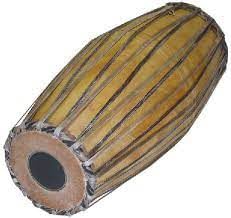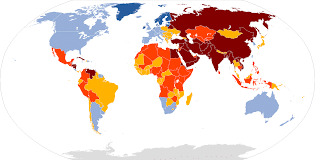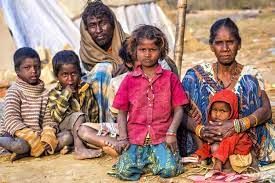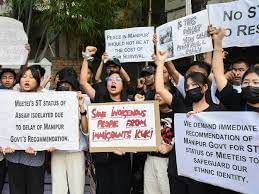UPSC Daily Current Affairs- 6th May 2023 | Current Affairs & Hindu Analysis: Daily, Weekly & Monthly PDF Download
GS-I
Buddha Purnima
Why in News?
Buddha Purnima is being celebrated recently.
About:
- It not only marks the day when Gautam Buddha was born but also the day when he attained Nirvana under the Mahabodhi tree at Bodh Gaya.
- Lord Buddha was born as Prince Siddhartha Gautama on the full moon day in 563 BC at Lumbini in Nepal.
- In Hinduism, Buddha is considered as the ninth avatar of Lord Vishnu.
- His birth anniversary is also known as Vaisakhi Buddha Purnima or Vesak.
- This day is commemorated by Buddhists and Hindus all over the world and is a major festival in countries like India, Nepal, Bhutan, Burma, Thailand, Tibet, China, Korea, Laos, Vietnam, Mongolia, Cambodia, Singapore, Indonesia and Sri Lanka.
Source: Newsonair
What is Mridangam?

Why in News?
Legendary mridangam ‘vidwan’ Karaikudi R Rani recently died due to age-related issues.
About Mridangam:
- It is one of the oldest Indian percussion instruments, originating 2,000 years ago.
- This traditional instrument is found in various parts of South India.
- It is a popular bifacial drum of Carnatic music and is used as an accompaniment in South Indian Classical music.
- It is also known by the name of maddal or maddalam.
- It is held across the lap and played on both ends with the hands and fingers.
- A similar instrument, the pakhavaj, is played in the Hindustani tradition of northern India, as well as in Pakistan and Bangladesh.
- Making process:
- The body of the mridangam is scooped out of a single block of wood.
- Jack wood or redwood is the ideal choice of mridangam makers, but the wood of the morgosa tree or the core of the coconut tree and the palm tree is also used for this purpose.
- Shape: It is shaped like a barrel whose right head is a little smaller than the left.
- Layered parchments, fastened to leather hoops and kept intact and tight by leather braces, control the skin tension.
- At times, small pieces of wood are also put in between these braces to facilitate the tuning.
- A removable patch of tuning paste is affixed to each end, giving the drum a definite pitch.
Source: The Print
GS-II
World Press Freedom Index

Why in News?
The World Press Freedom Index was released recently.
About World Press Freedom Index:-
- The World Press Freedom Index is published every year since 2002 by Reporters Sans Frontieres (RSF) or Reporters Without Borders.
- Reporters Without Borders: it is an independent NGO based in Paris with consultative status with the United Nations, UNESCO, the Council of Europe and the International Organization of the Francophonie (OIF).
- OIF: 54 french speaking nations collective.
- The Index ranks countries and regions according to the level of freedom available to journalists.
- However, it is not an indicator of the quality of journalism.
- Scoring Criteria:-
- The Index’s rankings are based on a score ranging from 0 to 100 that is assigned to each country or territory, with 100 being the best possible score.
- Evaluation Criteria:-
- Each country or territory’s score is evaluated using five contextual indicators.
- These include political context, legal framework, economic context, sociocultural context and safety.
World Press Freedom Index 2023 Rankings:-
- Norway, Ireland and Denmark occupied the top three positions in press freedom.
- Vietnam, China and North Korea constituted the bottom three.
- India’s ranking in the 2023 World Press Freedom Index has slipped to 161 out of 180 countries.
Source: The Hindu
Prevention of Sexual Harassment (Posh) Act, 2013

Why in News?
A recent investigation revealed that more than half of India’s 30 national sports federations do not have an Internal Complaints Committee (ICC) which is a legal requirement under the Prevention of Sexual Harassment (PoSH) Act, 2013.
About Prevention of Sexual Harassment (PoSH) Act, 2013
- The Government of India has enacted ‘the Sexual Harassment of Women at Workplace (Prevention, Prohibition and Redressal) Act, 2013’ (POSH Act) with the aim to provide a safe and secure work environment to women.
- It broadened and gave legislative backing to what is known as the Vishaka Guidelines, which were laid down by the Supreme Court in a judgment passed in 1997.
- The Vishaka Guidelines defined sexual harassment and imposed three key obligations on institutions — prohibition, prevention, and redress.
- The Supreme Court directed that they should establish a Complaints Committee, which would look into matters of sexual harassment of women in the workplace.
- The court made the guidelines legally binding.
Features
- It mandated that every employer must constitute an Internal Complaints Committee (ICC) at each office or branch with 10 or more employees.
- It lay down procedures and defined various aspects of sexual harassment, including the aggrieved victim, who could be a woman “of any age whether employed or not”, who “alleges to have been subjected to any act of sexual harassment”.
- The aggrieved victim under the Act can be a woman “of any age whether employed [at the workplace] or not”, who “alleges to have been subjected to any act of sexual harassment”.
- In effect, the Act protects the rights of all women who are working or visiting any workplace, in any capacity.
- The Act in its Section 2n, defines sexual harassment. Sexual harassment includes any one or more of the following unwelcome acts or behaviour (whether directly or by implication), namely
- Physical contact and advances, or
- A demand or request for sexual favours, or
- Making sexually coloured remarks, or
- Showing pornography, or
- Any other unwelcome physical, verbal, non verbal conduct of sexual nature
- Section 3 (2) of the Act further elaborates that if any of the following circumstances occurs or is present in relation to or connected with any act or behavior of sexual harassment among other circumstances, it may amount to sexual harassment-
- Implied or explicit promise of preferential treatment in her employment, or
- Implied or explicit threat of detrimental treatment in her employment, or
- Implied or explicit threat about her present or future employment status, or
- Interference with her work or creating an intimidating or offensive or hostile work environment for her, or
- Humiliating treatment likely to affect her health or safety
- Procedure for complaint: It is not compulsory for the aggrieved victim to file a complaint for the ICC to take action.
- she “may” do so — and if she cannot, any member of the ICC “shall” render “all reasonable assistance” to her to complain in writing.
- The complaint must be made “within three months from the date of the incident”.
- After the ICC has filed its report: If the allegations of sexual harassment are proven, the ICC will recommend to the employer to take action “in accordance with the provisions of the service rules” of the company. These may vary from company to company.
- The ICC may also recommend that the company deduct the salary of the person found guilty, “as it may consider appropriate”.
Issues and Concerns
- Sexual harassment at the workplace is becoming one of the most pressing issues affecting women across the globe.
- The Posh Act, 2013 does not satisfactorily address accountability. Notably, it does not specify who is in charge of ensuring that workplaces comply with the Act, and who can be held responsible if its provisions are not followed.
- Awareness about the Posh Act, 2013 is still low in certain areas, making it difficult for victims to report cases.
Suggestions
- The State Women Commissions should monitor the constitution of Internal Complaint Committees and Local Complaint Committees at district level in their respective States.
- The State Women Commissions should regularly hold programmes to disseminate information about provisions of Act and rules thereto in their respective States for its better implementation.
- Educate all staff on the various aspects of sexual harassment and the necessary steps to be taken if a complaint is made.
- Establish a formal complaint procedure and ensure all complaints are addressed promptly and fairly.
- Ensure all employees know their rights and the procedure for making a complaint.
- Take disciplinary action against those found guilty of sexual harassment.
- Provide counselling services to both the complainant and the accused.
Source: The Hindu
India’s Hunger Paradox
Why in News?
A national effort to establish routine dietary and nutritional assessments for the entire population is the need of the hour.
About Food Security:
- Food security refers to the state in which all individuals in a country have access to sufficient, safe, and nutritious food to meet their dietary needs and preferences for an active and healthy life.
This involves various dimensions such as:
- Availability of food through production and imports
- Accessibility of food without any discrimination, and
- Affordability of food for everyone.
Zero Food Prevalence in India
NFHS-5 Data:
- As per the National Family Health Survey (NFHS-5), among mothers with a child between ages 6-23 months, 18 percent reported that their child did not eat any food, referred to as “zero-food”, in the 24 hours preceding the survey.
- Zero-food prevalence:
- 30 percent for infants aged 6-11 months.
- 13 percent among the 12-17 months old.
- 8 percent among the 18-23 months old.
- An estimated 60 lakh zero-food children of 6-23 months of age in India not getting to eat every day lies substantial deprivations in specific food groups.
- More than 80 percent had not consumed any protein-rich foods for an entire day (“zero-protein”).
- 40 percent did not eat any grains (roti, rice, etc) for an entire day.
- 6 out of 10 children do not consume milk or dairy of any form every day (“zero milk”).
Daily minimum calorie intake for a child as per the World Health Organisation (WHO):
- At six months of age, 33 percent of the daily calorie intake is expected to come from food.
- At 12 months of age, 61 percent of the daily calorie intake is expected to come from food.
- It is presumed that the child obtains the remaining calories through breastfeeding, meaning the child is breastfed whenever they need it throughout the day and night, and not solely when the mother can provide it.
- Percentage of food-sourced calories only increases further when a child cannot receive breast milk when needed.
Issues and challenges with current measures:
- Severe food insecurity:
- Going without food for an entire day at this critical period of a child’s development raises serious concerns related to severe food insecurity.
- Faulty assessment:
- The assessment of the extent of nutritional deprivation among young children in India has, thus far, relied on measures of anthropometric failure such as the percentage of children short for their age (stunting) or weighing less given their height (wasting), compared to a reference population.
- These anthropometric measures are, at best, proxies suggesting plausible overall deficiencies in the child’s environment, without any guidance on the specific nature of the deficiencies.
- Non-communicable diseases:
- The rising burden of cardiovascular and other non-communicable diseases in India, particularly among the rapidly growing “middle class”, is strongly linked to diet and nutrition.
- The Role of Poshan 2.0:
- Mission Poshan 2.0 is a flagship program dedicated to maternal and child nutrition in India.
- However, appropriate food-based metrics are not developed to monitor and assess the program’s performance effectively.
Measures India should take to fight Hunger:
- A national effort to establish routine dietary and nutritional assessments for the entire population is the need of the hour.
- Appropriate food-based metrics should be developed to effectively monitor and assess the performance of Poshan 2.0.
- The zero-food metric provides a good start.
- The success of the Swachh Bharat Mission (SBM) offers valuable insights for Poshan 2.0, in its strategic use of directly trackable metrics, as well as a strong political commitment at the highest levels.
- Measuring the availability, accessibility and affordability of nutritious food, especially for disadvantaged and vulnerable populations such as young children, women should be the foundation for any evidence-based policy to end hunger and improve nutritional security.
India has taken several initiatives to achieve food security and end hunger, including:
- Mid-day Meal Scheme: The Mid-day Meal Scheme provides hot, cooked meals to school children to improve their nutritional status and increase school attendance.
- Integrated Child Development Services (ICDS) Scheme: The ICDS Scheme provides a package of services, including supplementary nutrition, health check-ups, and pre-school education, to young children and pregnant and lactating mothers.
- Mission Poshan 2.0: Launched in 2021, Mission Poshan 2.0 is a flagship programme dedicated to maternal and child nutrition, with a focus on food-based initiatives to achieve the SDG of zero hunger.
- National Nutrition Mission (Poshan Abhiyaan): Launched in 2018, the mission aims to reduce malnutrition among children, adolescent girls, and pregnant and lactating mothers by providing nutritional supplements and promoting behavioural change through community mobilization.
- Agriculture and Rural Development Initiatives: India has various agriculture and rural development initiatives to increase food production, enhance rural livelihoods, and reduce poverty, such as the Pradhan Mantri Fasal Bima Yojana, Pradhan Mantri Krishi Sinchai Yojana, and Deen Dayal Antyodaya Yojana-National Rural Livelihoods Mission.
Way Forward:
The need of the hour is to make addressing child malnutrition the top priority of the government machinery, and all year around. Thus fixing the pre-existing schemes is the obvious answer to addressing India’s multi-dimensional nutrition challenge.
Source: Indian Express
GS-III
Mukundra Hills Tiger Reserve

Why in News?
A nine-year-old full-term pregnant tigress suffering from severe constipation recently died at the Mukundra Hills Tiger Reserve (MHTR) during treatment.
About Mukundra Hills Tiger Reserve:
- Location:
- Mukundra Hills Tiger Reserve, popularly known as Darrah Wildlife Sanctuary, is spread across 4 districts – Bundi, Kota, Jhalawar & Chittorgarh in Rajasthan.
- The park is situated in a valley formed by two parallel mountains viz. Mukundra and Gargola.
- It is consisting of three wildlife sanctuaries: Darrah wildlife sanctuary, Chambal wildlife sanctuary and Jaswant Sagar wildlife sanctuary.
- This tiger reserve was once a hunting preserve belonging to the Maharaja of Kota.
- River: It is located on the eastern bank of the Chambal River and is drained by its tributaries.
- Vegetation: Dry Deciduous Forest
- Flora:
- Anogeissus pendula (Kala Dhok or Kaladhi) is the predominant species, along with Khair (Acacia catechu), Ber (Zizyphus mauratiana), Kakan (Flacourtia indica), Raunj (Acacia lecofolia) etc.
- On higher slopes, Anogeissus pendula is replaced by Anogeissus latifolia, along with Bel (Aegle marmelos), Salar (Boswellia sarata) Uum (Meliusa tomentosa) and Shisham (Dalbergia latifolia).
- Fauna:
- The important fauna includes Leopard, Sloth bear, Nilgai, Chinkara, Spotted Deer, Small Indian Civet, Toddy Cat, Jackal, Hyena, Jungle Cat, Common Langur etc.
- The common reptiles and amphibians are Pythons, Rat Snake, Buff-striped keelbacks, Green keelback, crocodiles, Gharial, Otter and Turtles
Source: The Print
Violence in Manipur & Meitei community’s Demand for ST status
Why in News?
Recently, violent clashes broke out at various places in Manipur during the course of a ‘Tribal Solidarity March’ called on by the All Tribal Students’ Union of Manipur (ATSUM).
- Hundreds of houses, churches, temples, and vehicles were either vandalised or set ablaze & Many were killed during the clash.
More about the news
- Unrest at the ‘Tribal Solidarity March’:
- March was called to oppose the longstanding demand that the Meitei community be included in the list of the state’s Scheduled Tribes (ST), which received a boost from a recent order of the Manipur High Court.
- Other reasons of unrest:
- Unrest has been brewing among the hill tribes of the state for a number of reasons.
- A major reason for the discontent has been the state government’s notices since August 2022 claiming that 38 villages in the Churachandpur-Khoupum Protected Forest area (in Churachandpur and Noney districts) are “illegal settlements” and its residents are “encroachers”.
- Following this, the government set out on an eviction drive which resulted in clashes.
- Unrest has been brewing among the hill tribes of the state for a number of reasons.
Scheduled Tribes status Demand by the Meitei community
- About:
- There has been an organised push in support of this demand for at least since 2012, led by the Scheduled Tribes Demand Committee of Manipur (STDCM).
- Plea before the Manipur High Court:
- The recent plea before the Manipur High Court was by the Meetei (Meitei) Tribe Union.
- The ple was seeking directions to the Manipur government to submit a recommendation to the Union Ministry for Tribal Affairs for the inclusion of the Meetei/Meitei community in the list of Scheduled Tribes in the Indian Constitution, as a “tribe among tribes in Manipur”.
- Why does the Meitei community want ST status?
- Loss of identity:
- In their plea before the High Court, the petitioners argued that the Meitei community was recognised as a tribe before the merger of the princely state of Manipur with the Union of India in 1949.
- They also claim that they lost their identity as a tribe after the merger.
- Preserving the community & land rights:
- It was argued in court that the demand for ST status arose from the need to “preserve” the community, and “and save the ancestral land, tradition, culture and language” of the Meiteis.
- The Meitei/Meetei have been gradually marginalised in their ancestral land.
- It was argued in court that the demand for ST status arose from the need to “preserve” the community, and “and save the ancestral land, tradition, culture and language” of the Meiteis.
- Victimization of the community & reduction in population:
- In various pleas to the state and central governments, the STDCM has stated that as a result of being left out of the ST list, “the community has been victimised without any constitutional safeguards to date.
- Their population which was 59% of the total population of Manipur in 1951 has now been reduced to 44% as per 2011 Census data”.
- Loss of identity:
Manipur High Court’s order
- The court observed that “the petitioners and other Unions are fighting long years for inclusion of Meetei/Meitei community in the tribe list of Manipur”
- Court also directed the government to submit its recommendation after considering the case of the petitioners, “preferably within a period of four weeks” of receipt of the order
Opposition by the other tribal groups
- The demand for ST status for the Meitei community has long been opposed by the state’s tribal groups.
- Dominance of the Meiteis:
- One of the reasons cited for the opposition is the dominance of the Meiteis, both in population and in political representation, since 40 out of 60 Assembly constituencies of the state are in the valley.
- Loss of opportunities:
- The ST communities of Manipur have been consistently opposing the inclusion, fearing the loss of job opportunities and other affirmative actions granted to STs by the Constitution of India to a much advanced community like the Meitei.
- Pre existing status & opportunities:
- Other arguments against the demand have been that the Manipuri language of the Meiteis is included in the Eighth Schedule of the Constitution, and that sections of the Meitei community — which is predominantly Hindu — are already classified under Scheduled Castes (SC) or Other Backward Classes (OBC), and have access to the opportunities associated with that status.
Source: The Hindu
|
38 videos|5293 docs|1118 tests
|



















